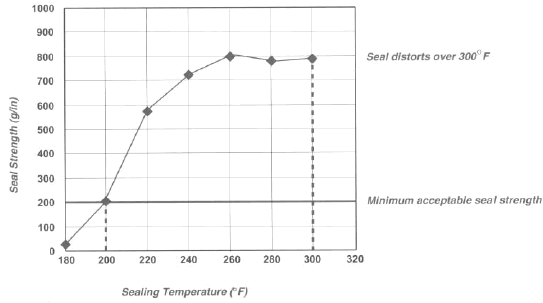Crimp Seal Strength, MST & Range
Definition
Relevance to performance
What determines a film's seal properties
Test principles
Related Terminology
Definition
Crimp seals, which are produced at controlled conditions of jaw design, temperature, pressure, and dwell, are measured in terms of force required to open the seam. The following properties are calculated and reported.
- Crimp seal strength is the maximum force to peel open a seal made at specified conditions. Units are gf/in or gf/2.5 cm.
- Crimp minimum sealing temperature (Crimp MST) for a specified pressure and dwell, is the temperature (°F or °C) required to achieve a certain minimum strength seal. ExxonMobil has standardized with 200 g/in as the seal strength for minimum acceptable performance. Other values may be more appropriate for particular applications.
- Seal range is the difference between the maximum and minimum temperatures that will produce an adequate seal at a specified pressure and dwell. Units are of or °C.
Relevance to performance
The strength of a seal is important to package integrity, and many end-users specify a minimum requirement.
Crimp MST and seal range are important, because they predict packaging machine efficiency and productivity. A lower MST corresponds to a wider seal range and, therefore, a wider operating window. This means that the packaging line will produce acceptably sealed packages even when the speed is ramping up and down, or when there is variation in jaw temperature. On the other hand, a higher MST and narrower seal range forces the packager to control these variables better, or else packages can be rejected for weak, open seals, or distorted seals.
What determines a film's seal properties
A film's sealing surface is a coated or coextruded layer. The sealing properties can be impacted by several factors:
- Formulation of sealant layer (resin and additive recipe)
- Thickness of sealant layer
- Total thickness of the film (With thicker films, it takes longer for heat to transfer from the sealing jaws to the sealing surfaces than it does with thinner films. Therefore, both the effective sealing temperature and the resulting seal strength are lower.)
- Bond strength of sealant layer to adjacent layer
- Contamination (An otherwise good-sealing surface may not seal well if additives from a laminating web transfer onto it, or if dust/fines are trapped in the seal area.)
- Surface treatment, including backside treatment, can damage sealability
Seal properties are a key design criteria when developing a sealable film. In production, these properties are regularly measured to make sure that the formulation or process has not shifted.
Test principles
In order to compare sealing properties among different films, ExxonMobil uses a set of standard conditions for producing heat seals. They are summarized in Table 12.
| Condition | Description |
|---|---|
| Sealing device | Wrap-Ade Crimp Sealer Model J or K, modified with new PID temperature controllers |
| Jaw design | Vertically serrated crimps |
| Temperature | Both jaws are heated and desired set point is controlled to ± 2ºF (1ºC) |
| Pressure | 20 psi (1.4 bars) |
| Dwell | ¾ sec |
| Table 12: ExxonMobil conditions for producing test crimp seals | |
After a test seal has been produced, its strength can be measured with a tensile tester or a Suter tester. ExxonMobil typically uses the simpler Suter tester, which pulls the seal apart at 12 in/min and records peak force.
ASTM and ExxonMobil test procedures have similarities and differences. Unlike ExxonMobil, the scope of ASTM test procedure F 88 is only the measuring of the force to open the seal, not the making of the seal at a set of standard conditions. ASTM specifies the use of a tensile tester, while ExxonMobil uses a Suter tester. The 12 in/min pull rate of ExxonMobil is within the ASTM-defined a rate of 10 to 12 in/min.
It is often desirable to produce seals at a series of temperatures, measure the seal strengths, and develop a seal curve that looks like in Graph 3.
 |
| Graph 3: Typical seal curve |
Crimp Seal Strength is defined at a particular temperature, or as the average for a range of temperatures. For the seal curve represented in Graph 3, the following properties can be derived.
Seal Strength at 260°F (SS260F) = 800 g/in
SS260 - 300F = 790 g/in
Minimum Sealing Temperature for a 200 g/in seal (MST200g) = 200°F (93°C)
MST500g = 217°F (103°C)
Seal Range (SR) = Maximum - Minimum Sealing Temperature
SR200g = 300 - 200 = 100°F (56°C)
SR500g = 300 - 217 = 83°F (46°C)
The horizontal red line denotes a minimum acceptable seal strength of 200 g/in. It intersects the seal curve at 200°F (93°C), so this is the MST200g. If you know that the minimum acceptable seal strength is another value, the same curve may be used to determine the corresponding MST and seal range. For example, 500 g/in seals occur at 217°F (103°C), so this is the MST500g.
Most OPPs will distort at temperatures above 300°F (149°C), if dwell time is in excess of ½ second or so. Therefore, this value is used as the maximum sealing temperature. The difference between the maximum and minimum sealing temperatures is equal to the seal range.
CAUTION: Seal data cannot be compared when the seals are produced on different equipment or at different conditions.
Related terminology
ASKCO sealer: The ASKCO sealer is a laboratory heat sealer that ExxonMobil uses for process control of coated films. It has nine separate temperature controlled, one-side heated, low-pressure, flat-sealing stations. The multiple stations allow a whole seal curve to be generated from one sealed film strip.
Sentinel sealer: The Sentinel sealer is a common laboratory heat sealer in the flexible packaging industry. Like the ASKCO sealer, it is a one-side heated, flat sealer. Unlike the ASKCO, there are no multiple stations, so it can only make a seal at one temperature at a time. ExxonMobil does not use this sealer. Data generated with the Sentinel sealer, by other companies, can not be compared with ExxonMobil data.
Failure mode: Failure mode refers to how the seal fails as it is being pulled apart. A "peel" failure means that the films separated without tearing. A "delamination" failure is a type of peel failure where the material separates between two adjacent layers, rather than at the sealing interface. (For example, a printed extrusion lamination can fail between the ink and poly layers, because they formed a weak bond.) Finally, a "tear" failure means that the film tears as the seal is being pulled apart. This suggests that the seal and the bonding between layers are stronger than the film.
Suter tester: Suter tester is a device specifically designed to measure peak seal strengths. It is simpler and speedier than using a tensile tester. Suter testers are not commercially available.

